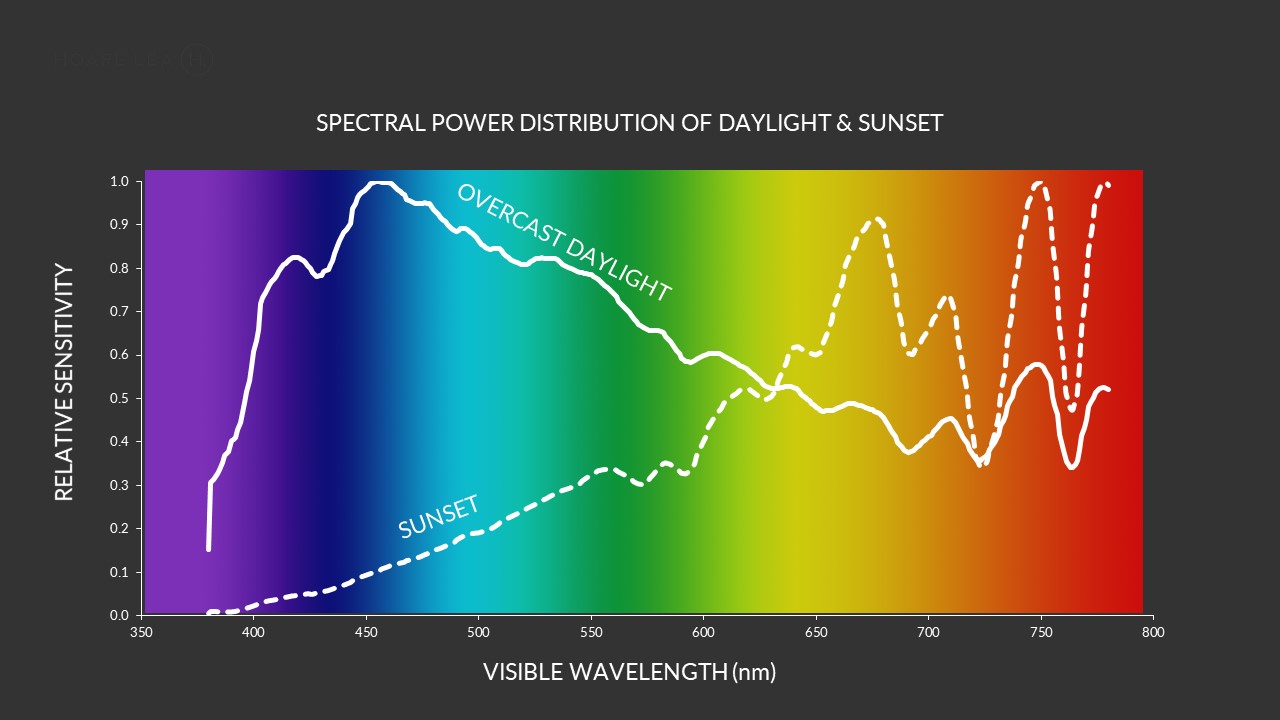Insights
m-EDI: A revolution in our understanding of light and health.
Building on a breakthrough, with a new metric for modern living.
In an early 2019 Insight I wrote about the broad subject of Circadian Lighting. I spoke of a widening understanding in the science, and the further research needed to quantify what we need.
At the time, the big news on the street was that the ‘melanopic’ spectrum of light, or the colours of light that are key to stimulating our circadian system, had recently been defined.
The Equivalent Melanopic Lux (EML) introduced by Lucas and et al (2014) was the metric and methodology which looked at multiplying photopic illuminance (daytime eye sensitivity) by a ‘melanopic ratio’. This gave a resultant value for melanopic lux which formed the basis of melanopic calculations and became ubiquitous in the WELL Standard.
The beauty of this breakthrough was that it allowed us to define how a light source responds in terms of our circadian activity and that this light needed to hit the back of our eyes and engage our IPRGCs (intrinsically photosensitive retinal ganglion cells) which sit within the cells of the retina.
What was not provided were the actual values of illuminance that we need to ensure healthy entertainment of our circadian system. In other words, we had a methodology of defining the light spectrum needed but no way of knowing how much of this light we need.
The outdoor environment gave us some clues.
Daylight changes throughout the day and in response to climate and geography but, in general during our awake hours, it is high in blue spectrum and bright – over 10,000 lux and up to 100,000 lux on a sunny day. As the sun sets, the blue spectrum falls, and the light becomes warmer and less bright.

Graph showing daylight and sunlight in visible spectrum. You can see daylight is high in blue spectrum, but this decreases as the sun sets with greater red spectrum into the evening. This suggests we need rich blue bright light during the day and warmer, dimmer light as we approach sleep.
This was a great indication that we need more light that’s high in blue spectrum when we are awake, and warmer, dimmer light as we start to relax and get closer to sleep.
The natural environment also suggested that we benefit from darkness or near darkness for sleep.
But for an artificial lighting system that imitates the characteristics of natural light to be useable, these clues needed to be pieced together into a definable solution – one that could be specified and calculated in a similar way to a normal lux calculation.
A lot has changed since 2019 and often it is hard to keep up, but the changes in understanding are exciting and have the potential to make real differences to people’s lives.
What have we learned?
1. It is all about spectrum and not about colour temperature. Real-life case studies using new broad spectrum LED (LED which provides light in spectrum like that of daylight) have shown that it is possible to change spectrum of light which responds to people’s physiological needs without moving into cooler colour temperatures (CCT) of light which may not provide a comfortable interior environment.

Source: Tuning into the body clock: spectrally tunable lighting systems.
This means we can have circadian supportive lighting systems which no longer need to simply dim between warm and cool light but can move through the spectrum to create human centric and biologically responsive spaces. This may make the light quality more attractive to people.
2. Equivalent Melanopic Lux (EML) has been replaced and we should now be using Melanopic Equivalent Daylight Illuminance or m-EDI. It is complicated mathematics but, in short, EML did not provide an SI unit for calculating lux, so it was modified to an equivalent SI model of illuminance.
The output melanopic ratio of m-EDI is a little more onerous than EML (EML is about 10% less than m-EDI) which suggests some of the lower previous recommendations of the WELL Standard may need to be reconsidered. However, in general the m-EDI metric represents a valuable step in the journey.
3. The industry has seen research-backed evidence that lighting that is designed to meet our physiological and biological needs can support our circadian system; enhancing our alertness and productivity throughout the day and encouraging quality sleep into the evening and night. This research has shown that light can benefit the health and wellbeing of office workers, school children, hospital patients and clinical staff, elderly people and night shift workers. In fact, there are benefits in all areas of our human interactions with light and there is a greater understanding of the needs of people via either daylight or artificial light throughout our 24-hour day.
4. There are now values for light throughout the day. This is game changing. In late 2019 a collection of the world’s leading neuroscientists, psychologists and chronobiologists gathered in Manchester for the second International Workshop on Circadian and Neurophysiological Photometry. The outcome was a series of m-EDI values which suggest a minimum value required throughout the day and maximum values in the evening and while sleeping.
These min/max values offer great opportunities in all aspects of the built environment and remove the excuse that we do not know broadly how much light is needed. Like all illuminance guidance they are not definitive as everyone is different, but they do offer a framework around which healthy exposure to light (day and night) can be evaluated.
Recommendations.
The illuminance levels needed are defined below. It is worth noting that these represent normal photopic lux values multiplied by a melanopic ratio which is defined by adding spectrum measurements to a toolbox such as that of the Luox app.
It should also be stated that, if you can, you should maximise exposure to daylight either within buildings or by making a deliberate effort to get external exposure to daylight. This could be achieved by a nice, bright commute to work; taking a walk; getting regular fresh air breaks.
However, as Covid has taught us, the availability of good quality daylight is a luxury that many do not get in their homes and workplaces so the values below can be provided by artificial illumination as well as daylight.

Conclusion.
By designing light at the eye to these maximum and minimum values we can design truly human responses to spaces, but we must be careful not to jump to simple answers and create spaces which ignore the basics of good lighting design.
These recommendations are designed to be an additional consideration to normal lighting guidance and not a replacement, but in order to achieve higher vertical illuminance levels they suggest we may need higher illuminance levels at the task area. This would seem to contradict the need for buildings to reduce energy consumption to meet the demands of Net Zero Carbon .
As a previous Insight explored, we will need to reconsider the norms of standard lighting practice. We need to start considering light at the eye as well as on the horizontal plane, and we need to stop seeing light as a utility like gas, electricity, or water but instead as an intrinsic part of our, and our families’, health and wellbeing management.
